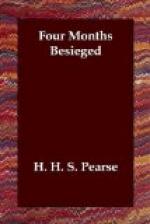not actually join the ranks for a time to escape detection.
But a sound greeted their ears at that moment, and
knowing what it meant, they scampered downhill without
waiting to hear more. It was a ringing British
cheer followed by strident commands to “Fix
bayonets and give the devils cold steel.”
Begun by Major Karri Davis, the order ran along from
Imperial Light Horse to Carbineers, who had not a
bayonet amongst them, for irregular mounted infantry
in this country do not carry such weapons. But
they struck the butts of their rifles on rocks, and
made a great clatter as if preparing for a bayonet
charge, and cheered again and again for a good deal
more than their actual numbers, while crags on each
hand tossed the shouts to and fro in a mighty tumult.
This was apparently too much for the small number of
Boers who held the crest. Letting off bullets
in rapid succession, until the magazines were exhausted,
they turned and bolted, having hit only ten of our
men, one of whom, the tallest trooper in the Imperial
Light Horse, was badly wounded. In proportion
to their numbers the guides suffered most, having
four out of fourteen hit, though none very severely.
The worst wound of all was from an explosive bullet
similar to those used in Express rifles for big-game
shooting, and many missiles of the same kind were
seen to burst with a flash like shells as they struck
on stones round about, thus proving that the use of
explosive bullets by Boers is not quite so rare as
most of us have believed hitherto. Major Henderson
received three wounds from buck-shot or “loupalin,”
one of which penetrated deeply, but caused so little
shock at the time that he was able to keep pace with
the best uphill. Nevertheless, “scatter
guns” are not weapons proper to be used in warfare
between civilised combatants.
Halting for a brief breathing space, now and again,
at General Hunter’s command, then following
with all the speed they could muster where he and
his aide-de-camp, Major King, led the Imperial Light
Horse on the left, the Carbineers on their right made
a final dash for the steepest climb of all, and, breathless,
gained the ridge, to find that the Boers had quitted
it, leaving not a man in defence of the guns.
A great stroke of luck befell the Imperial Light Horse,
who crossed the heights with their left flank opposite
a Boer 12-pounder and Maxim gun. The latter they
made a clean capture of, but the field-piece, being
too heavy for them to carry off, was left to the tender
mercies of the engineers, who soon had bracelets of
gun-cotton round it, and the breech-pieces damaged
beyond repair.
Meanwhile the right flank was sweeping round towards
the main battery in expectation of meeting with some
resistance from the gun’s crew of “Big
Ben of Little Bulwaan.” That weapon had,
in virtue of similar qualities, succeeded to “Long
Tom’s” second title, but did not live long
to enjoy it. The end of his active career was
at hand when the Light Horse made their dash for him




